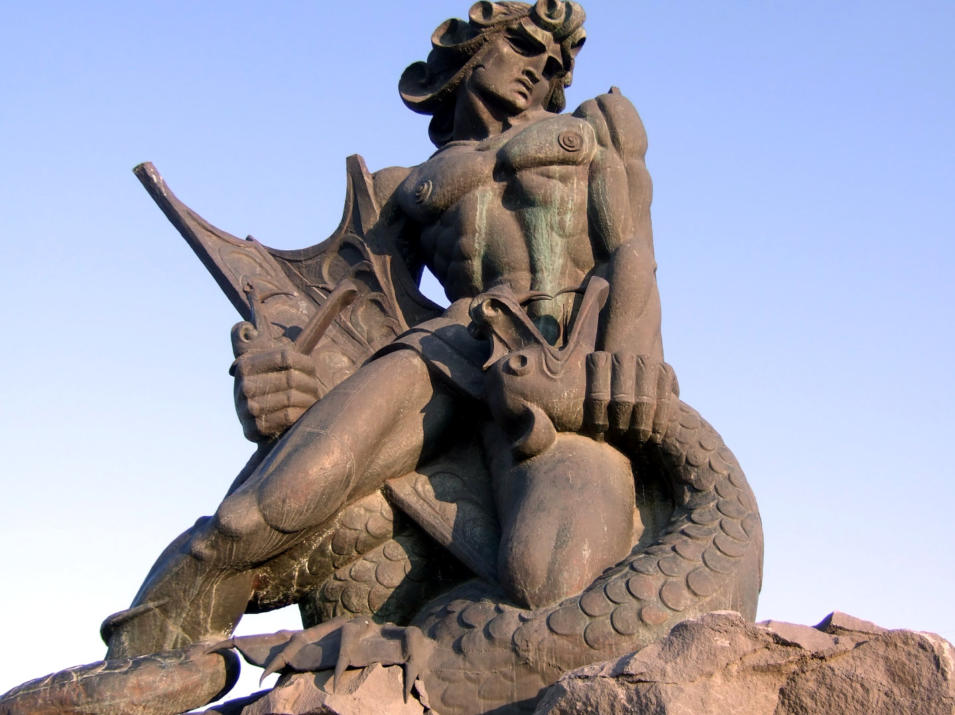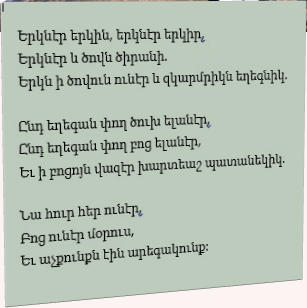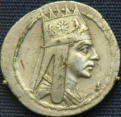

Armenian Jerusalem



First known Armenian epic
In
Armenian
mythology,
Vahakn
Vishabakagh
was
a
god
of
fire
and
war
worshiped
anciently
and
historically
in
Armenia,
a
member
of
a
troika
of
deities
along
with
with
Aramazd
and
Anahit.
He
has
also
been
identified
as
the
Greek
deity
Hercules.
In
the
Armenian
translation
of
the
Bible,
"Hercules,
worshipped at Tyre" is renamed "Vahakn".
All
those
ancient
heroes
were
treated
as
gods
living
among
men.
Vahagkn
was
enlisted
within
the
ranks
of
the
Armenian
kings,
as
a
son
of
the
Orontid
Dynasty
(or
Yervanduni
dynasty,
6th
century
B.C.),
together with his brothers — Bab and Tiran.
This
is
how
the
great
Armenian
historian,
Movses
Khorenatsi,
describes
the
origins
of
Vahakn
in
his
immortal birth song:
In travail were heaven and earth,
In travail, too, the purple sea!
The travail held in the sea the small red reed.
Through the hollow of the stalk came forth smoke,
Through the hollow of the stalk came forth flame,
And out of the flame a youth ran!
Fiery hair had he,
Ay, too, he had flaming beard,
And his eyes, they were as suns!
This
is
the
only
part
of
the
epic
that
has
survived.
Hisrtorians
believe
that
the
other
stanzas
of
the
poem
described
how
Vahakin
fought
and
vanquished
dragons,
earning
himself
the
title
of
“Vishabakagh”,
(dragon
reaper),
from
“vishab”
(dragon)
and
“kaghel”
(to
reap).
He
embodied
the
ideals
of
courage,
steadfastness
and
loyalty,
qualities
also
enjoyed
by
Hercules.
He
was
also
worshipped
as
a
sun-god,
a
rival of Baal-shamin and Mihr.
Over
the
years,
the
song
gained
in
popularity
and
was
sung
to
the
accompaniment
of
a
lyre,
long
after the conversion of Armenia to Christianity.
The
reed
is
an
important
ingredient
in
ancient
mythology
because
of
its
connection
with
fire
in
its
three forms.

The
ancient
pagan
Armenian
cosmology
boasted
some
of
the
most
endearing
heroes
and
deities,
chief
among
them
Haig,
who
is
acknowledged
as
our
prime
ancestor.
Stories
of
his
blood-curdling
battles
with
the
evil
Pel/Bel
are
awe-inspiring:
they
both
enthralled,
terrified
and
entertained
us
as
we
sat
at
the
feet
of
our
teachers
at
our
parish school, the Tarkmanchats.
Sassoutsi
Tavit
(David
of
Sassoon),
the
shepherd
boy,
was
the
scourge
of
the
scavenging
lions,
and
would
sleep
“noosh
noosh”
with
a
rock
for
a
pillow,
without
a
care
in the world, until the morning.
One
of
the
most
inspiring
memories
we
cherish
is
the
discovery
of
the
first
known
Armenian
epic,
the
tale
of
Vahakn
the
Dragon
Slayer.
The
one
with
the
red
beard
and
eyes like the sun.
The
passage
on
the
left
is
the
earliest
known
piece
of
Armenian
literature.
An
all
too
brief
epic
poem
that
embodies
nodes
of
the
quintessential
excellence
of
our
Armenian
language. An English translation appears below.























